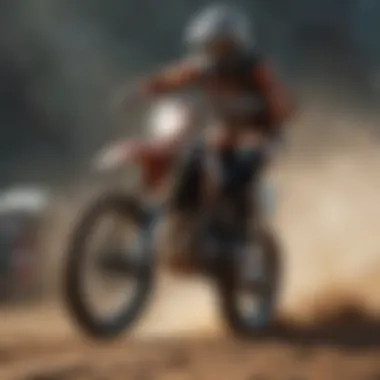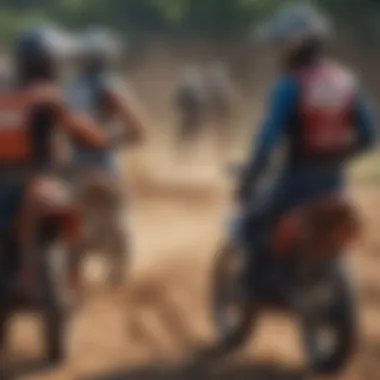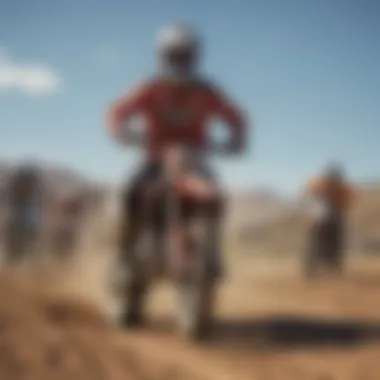Exploring the Intricate World of Motocross Riding


Intro
Motocross, an exhilarating sport that challenges the limits of skill, strength, and tenacity, has captivated riders and spectators alike. This intricate world is filled with rich history, a distinct culture, and a vibrant community. As riders navigate through challenging terrains, they not only seek thrill but also engage in a vast network of shared experiences, camaraderie, and competitions. Understanding the various aspects of motocross is essential for both newcomers and seasoned enthusiasts, enabling a deeper connection to the sport.
The History of the Sport
Origin and Evolution
Motocross traces its roots to the early 20th century, evolving from earlier forms of motorcycle racing in Europe. Initially, it was a competition held on rugged terrain, designed to test riders' endurance and their machines' capabilities. The term "motocross" itself began to gain prominence in the 1920s, with the sport growing rapidly in popularity post-World War II.
Milestones and Influences
The development of motocross can be marked with significant milestones, such as the establishment of the first motocross championship in 1957. Regulatory committees began setting rules, thus formalizing competitions. Additionally, the introduction of lightweight bikes in the 1970s allowed for greater agility and speed, fundamentally changing the sport's dynamics.
Key Athletes and Pioneers
Throughout motocross history, several figures have emerged as true pioneers. Riders such as Roger DeCoster and Bob Hannah have left lasting legacies, both in performance and in shaping the sport's future. Their contributions have inspired generations of racers, showcasing dedication and skill in an often perilous arena.
"Motocross is a sport of discipline, passion, and unparalleled adventure. Each twist of the throttle brings new challenges to master."
Techniques and Skills
Basic Techniques for Beginners
For newcomers, mastering the basics is essential. Developing a strong grip on the handlebars, maintaining body balance, and learning to correctly throttle are foundational skills. The transition between standing and sitting on the bike while navigating terrain is also crucial.
Advanced Skills to Acquire
Once basics are mastered, riders can progress towards more complex maneuvers like jumps and cornering techniques. Techniques such as body positioning during jumps, understanding momentum, and modulating speed can greatly enhance performance. Continuous practice is key for mastering these advanced skills.
Common Mistakes and How to Avoid Them
Many beginners often rush into jumps or take corners too aggressively. It's important to recognize that patience and timing are crucial. Focusing on gradual progress rather than speed will yield better results. Additionally, avoiding distractions during rides can help maintain focus and control.
Safety Measures
Essential Safety Gear
Safety should always be a priority in motocross. Essential gear includes helmets, gloves, goggles, boots, and body armor. Investing in high-quality protective equipment can significantly reduce the risk of injuries.
Safety Practices and Procedures
Understanding and adhering to safety practices is vital. Pre-ride inspections of the motorcycle for mechanical integrity should be routine, and riders should always be aware of their surroundings. Practicing in a controlled environment before venturing into more challenging terrains is recommended.
How to Prepare for Unexpected Situations
Unexpected situations can arise even with the best preparation. Knowing how to respond in emergencies, such as a mechanical failure or a fall, can be life-saving. It’s crucial for riders to remain calm and focused during such occurrences, assessing and addressing the situation promptly.
Gear Recommendations
Top Brands and Products
While many brands cater to motocross enthusiasts, some have established reputations for reliability and performance. Brands like Fox Racing, Alpinestars, and Troy Lee Designs are notable for producing high-quality motocross gear that withstands the rigors of the sport.
Budget vs. Premium Options
When selecting gear, riders face choices between budget and premium options. While budget choices may save money initially, investing in premium gear can often provide better durability and safety features. Assessing one’s needs and frequency of riding can guide this decision.
Maintenance and Care for Gear


Proper maintenance of gear is essential for longevity. Regular cleaning and inspection of helmets and protective clothing ensure they remain effective. Following manufacturer guidelines for care can enhance the lifespan of equipment.
Prelims to Motocross Riding
Motocross riding stands as a unique intersection of skill, adrenaline, and community. It involves not just the act of racing on dirt bikes but also encompasses a lifestyle intertwined with its rich history and vibrant culture. Understanding this intricate sport requires an appreciation for both the technicalities and the emotional drive that many riders experience.
Participating in motocross offers numerous benefits. It promotes physical fitness, enhances mental focus, and builds community among like-minded individuals. Racers often find a sense of camaraderie, sharing techniques and experiences. Furthermore, riding fosters resilience and determination, essential traits for navigating the challenges inherent to the sport.
Yet, it is crucial to acknowledge the considerations that come with motocross riding. The physical demands are substantial, necessitating robust fitness and coordination. Riders must also be aware of safety protocols to minimize risks associated with high-speed racing on challenging terrains. This introduction sets the stage to explore deeper realms of motocross, from its historical background to necessary skills, safety measures, and gear.
By delving into these elements, the reader gains a comprehensive understanding of what motocross riding entails, equipping them with the knowledge needed to either start or enhance their journey into this thrilling world.
Historical Context of Motocross
Understanding the historical context of motocross is essential for grasping the full spectrum of the sport. This section delves into the origins, evolution, and significant milestones that have shaped motocross as we know it today. Contextualizing these elements provides insight into the cultural significance and technological advancements within the sport. Through this exploration, both newcomers and seasoned riders can appreciate the depth of motocross riding and its community, ultimately enhancing their connection to this adrenaline-fueled pursuit.
Origins and Evolution of the Sport
Motocross traces its roots back to the early 20th century. The sport originated in the United Kingdom, emerging from scrambles, which were informal motorcycle races held on rough terrain. As vehicles became more reliable and powerful, organized races gained popularity. The first official motocross event occurred in 1924 at the Isle of Man when riders competed in a race through rugged landscapes.
The evolution of motocross continued throughout the decades. The introduction of lightweight bikes in the 1950s made the sport more accessible. Notable manufacturers, such as Honda and Yamaha, began producing dedicated motocross bikes, enhancing performance and safety. Over the years, motocross transformed from a niche activity into a globally recognized sport, with competitions drawing thousands of spectators.
Key Milestones in Motocross History
Several milestones mark the trajectory of motocross, indicating its growth and evolution over time:
- Formation of the Fédération Internationale de Motocyclisme (FIM): Established in 1904, FIM began overseeing motocross events, standardizing rules and safety measures for riders worldwide.
- The First Motocross World Championship: Introduced in 1957, this championship span set a benchmark for competitive motocross, promoting international participation and recognition.
- The Rise of Supercross: In the late 1970s, the adaptation of motocross to stadiums led to the creation of supercross, attracting new fans and providing riders with more controlled environments.
- Women in Motocross: The late 1990s witnessed a surge in female participation, with Jami Elot becoming the first woman to compete in the Motocross World Championship series, breaking barriers and paving the way for future generations.
- Technological Innovations: The development of electric bikes and advancements in gear technology have opened new avenues, promoting sustainability while ensuring rider safety.
"The growth of motocross not only signifies a change in sports culture but also reflects advancements in technology and community engagement."
The historical context of motocross not only emphasizes its rich traditions but also highlights how the sport continues to evolve, blending the past with modern innovations.
Key Skills for a Successful Motocross Rider
To become a successful motocross rider, one must cultivate a mix of essential skills. These skills not only enhance performance but also ensure safety on the track. The following sections delve into key elements that are crucial for any motocross enthusiast.
Fundamental Riding Techniques
Mastering fundamental riding techniques is the first step for every motocross rider. These basics form the foundation upon which advanced skills can be built.
Body Positioning: Riders must learn to shift their weight effectively. Leaning forward helps increase traction on the front tire during turns. Conversely, leaning back provides stability during jumps. Good body positioning allows for smoother handling in various terrain conditions.
Throttle Control: Smooth throttle control is vital. Too much throttle can lead to loss of traction, while too little can slow progress. Riders should practice finding the sweet spot between acceleration and control, enabling them to maintain speed effectively.
Braking Techniques: Understanding when and how to brake is essential. Riders must use both front and rear brakes, as relying solely on one can compromise control. Practicing emergency stops will build confidence and enhance safety.
"A skilled rider knows that throttle and braking are not just functions; they are tools for precision and control."
Observation Skills: Motocross riders must constantly scan the track for obstacles and opportunities. Awareness of the terrain can significantly impact performance. This skill evolves through experience and ongoing practice.
These fundamental techniques form the bedrock of motorcross riding. By honing these skills, riders prepare themselves for the more complex maneuvers that lie ahead.
Advanced Skills and Maneuvers
Once the basic techniques have been mastered, riders can progress to advanced skills and maneuvers. These skills elevate a rider's ability and enhance competitiveness.
Jumping Skills: Jumping is a hallmark of motocross. Riders must learn how to time their take-offs and landings effectively. Proper technique ensures a smooth landing, minimizing the risk of injury. Each jump requires a unique approach, influenced by speed and angle.
Cornering Techniques: Cornering is where many races are won or lost. Riders need to understand how to enter and exit corners fluidly. This involves effective braking, strategic body positioning, and maintaining traction. Practicing different cornering techniques can significantly enhance a rider's speed and control.
Riding on Various Terrains: Motocross racing often involves different surface types, including dirt, mud, and sand. Mastery of riding across these terrains demands adaptability. Riders should practice on varied surfaces to develop the necessary skills to handle each one effectively. This adaptability is crucial during competitive events.


Race Strategy and Tactics: Understanding the dynamics of a race can give riders a competitive edge. Developing a strategy based on the track layout and competitors can influence race performance. Riders must analyze their own capabilities and their opponents to make quick and decisive choices during a race.
Physical and Mental Demands of Motocross
Understanding the physical and mental demands of motocross is crucial for anyone involved in this sport. Riders face a unique blend of challenges that can significantly impact their performance. Physical endurance and mental fortitude are not just helpful; they are essential for success on the track.
Motocross involves navigating rugged terrains, handling aggressive maneuvers, and maintaining focus amid distractions. The combination of these elements creates a formidable experience that requires riders to be prepared in all aspects.
Physical Fitness Requirements
Motocross is a physically intensive sport. The demands placed on the body during racing and practice are considerable, and proper fitness training is vital. A motocross rider must possess strength, endurance, flexibility, and coordination. Here are a few key points regarding physical fitness:
- Strength Training: Upper and lower body strength is essential. Riders must handle the weight of their motorcycles while maintaining control during jumps and sharp turns. Core strength is especially important for balance and stability.
- Cardiovascular Endurance: High levels of endurance are necessary to withstand the rigorous demands of racing. Riders can be on the bike for extended periods, requiring excellent cardiovascular health to sustain energy levels.
- Flexibility and Mobility: Flexibility aids in maneuverability on the motorcycle. Being limber helps riders avoid injuries and allows for easier adjustment to the bike's movements. Incorporating stretching and mobility work into training can benefit performance.
- Coordination and Reaction Time: Quick reflexes and hand-eye coordination enable riders to react swiftly to obstacles and changing track conditions. Practicing drills can help improve these skills, making riders more effective on the track.
Mental Preparation and Focus
Mental preparation is equally pivotal in motocross. The sport is not just about physical capability; it requires the right mindset and concentration.
- Focus and Concentration: Riders must remain focused not only on their own performance but also on the actions of other riders and the track environment. Distracted thoughts can lead to mistakes, which in turn can have serious consequences.
- Stress Management: Racing can be stressful, with high stakes and competitive pressure. Developing strategies to handle stress, such as visualization techniques or mindfulness, can help maintain composure during races.
- Goal Setting: Establishing clear and attainable goals is important. Whether for personal improvement or competitive success, having defined objectives helps riders stay motivated and track their progress.
- Mental Resilience: The ability to bounce back from setbacks, such as crashes or poor performances, is crucial. Cultivating resilience through experience and support networks is essential for a long-lasting motocross career.
"Physical fitness and mental preparation are two sides of the same coin in motocross riding. Both require equal attention to achieve success on the track."
The intricacies of physical fitness and mental preparedness cannot be overstated. Riders who invest time in both aspects generally achieve greater success and satisfaction in their motocross journeys.
Essential Gear for Motocross Riders
In motocross, the right gear is vital. It serves not only for comfort but also for safety. Riders face numerous dangers. From falls to collisions, having protective equipment can make a difference between minor injuries and serious consequences. Additionally, choosing the appropriate riding gear can enhance performance on the track. This section will explore the essential items that every motocross rider should consider, emphasizing safety and functionality.
Protective Equipment Overview
Protective equipment forms the backbone of safety in motocross riding. Helmets are the first line of defense. A good quality helmet must meet safety standards and fit snugly. It reduces the risk of head injuries during crashes, which are common in the sport.
Apart from helmets, body armor is crucial. This includes chest protectors and back guards. These items protect vital areas from impacts and abrasions. Knee braces also provide support to the joints, reducing the risk of injury during jumps and turns. Finally, boots designed for motocross should provide ankle support and protect against impacts from the bike or the ground.
"Investing in protective gear is not just a choice; it’s an essential step toward ensuring a long and safe riding experience."
Riding Gear: Choosing the Right Equipment
Selecting the right riding gear is paramount for both safety and performance. When choosing motocross gear, several factors should be considered:
- Fit: Gear should not be too tight or loose. A well-fitted jersey, pants, and gloves allow for freedom of movement while keeping the rider safe.
- Material: Look for breathable, durable materials. These help in regulating temperature during rides and can withstand wear and tear.
- Functionality: Many gear items come with features like pockets or venting. These can improve the experience on longer rides.
For instance, when picking riding pants, ones with reinforced knees offer better durability. Jerseys might come in moisture-wicking fabrics, which can greatly increase comfort during more intense races.
Riders should also consider the climate. Different styles may be suitable for varying weather conditions, ensuring comfort throughout the experience.
Lastly, it is advisable to try on various brands, as sizes can differ. Getting a feel for how gear fits and moves on the body while simulating riding motions can lead to informed choices.
Motocross Safety Protocols
Safety is a cornerstone of motocross riding. The thrill of speed and technical challenges can come with certain risks that, if not properly managed, can lead to serious injuries. Implementing effective safety protocols minimizes these risks for riders. This commitment to safety not only protects the individuals involved but enhances the credibility of the sport as a whole. By prioritizing safety, motocross can continue to evolve and attract new riders while ensuring a responsible experience for all participants.
Understanding Risks and Safety Measures
Motocross riding is inherently risky due to the high speeds and uneven terrains involved. Riders face potential threats from falls, collisions, and environmental factors. Understanding these risks helps in formulating effective safety measures.
Key Risks to Consider:
- Falls: Riders can easily lose control due to jumps or obstacles.
- Collisions: These can occur with other riders or stationary objects on the track.
- Terrain Hazards: Mud, rocks, or uneven surfaces can pose additional dangers.
To mitigate these risks, several safety measures are recommended:


- Wearing Protective Gear: Helmets, gloves, knee pads, and other protective equipment should be mandatory.
- Pre-Ride Checks: Inspecting the motorcycle before riding can help avoid mechanical failures.
- Track Familiarization: Knowing the track layout helps riders anticipate challenges and respond appropriately.
"Safety isn't just a protocol; it’s a culture that promotes accountability and awareness among motocross riders."
Practice and Training for Safety
Regular practice and training are vital components of developing safe riding habits. This aspect of motocross not only improves a rider's skill set but also reinforces the importance of safety in the sport.
Effective Safety Practices:
- Routine Drills: Engage in exercises that enhance control and balance on the bike.
- Group Rides: Practicing with experienced riders offers valuable learning opportunities.
- Safety Workshops: Attend sessions focused on safety protocols and first aid training specific to motocross scenarios.
Establishing a routine that incorporates these elements contributes greatly to a rider's overall awareness and confidence, enabling them to safely navigate the complexities of motocross riding. Riders who invest time in their training create habits that not only protect themselves but also others around them in the motocross community.
Motocross Culture: Community and Events
Motocross culture is a vibrant tapestry that weaves together personal passion, competitive spirit, and a profound sense of community. It transcends the mere act of riding; it represents a lifestyle embraced by many. Understanding this culture is essential for both newcomers and veterans in the sport. The communal aspect cultivates friendship and promotes the sharing of knowledge, thus enhancing the riding experience.
The Community of Motocross Riders
The community of motocross riders is dynamic and diverse. It includes individuals from all walks of life, united by a shared enthusiasm for performance riding. Riders often congregate in local tracks, organized events, and informal gatherings. These interactions foster camaraderie and mentorship.
- Riders may participate in forums like reddit.com or social media platforms such as facebook.com. They exchange tips, share experiences, and troubleshoot various issues.
- Many riders also join clubs or associations, which provide resources for skill development and safety training. These groups often host training sessions and social events.
Motocross events create opportunities for riders to showcase their skills and connect with others. Local races, amateur competitions, and national championships encourage participation, creating lasting bonds among members of the community.
Major Competitions and Races
Motocross competitions are critical to the sport's culture. They serve as a platform for riders to demonstrate their abilities and push their limits. Events are organized at various levels, from local races to global championships, such as the AMA Motocross Championship.
- Competitive events often feature distinct classes based on age, skill level, and bike specifications. This structure encourages fair competition and growth among riders.
- The thrill of competition sparks motivation and commitment. Riders prepare rigorously, training both on and off the bike to compete effectively.
These competitions not only provide riders with an avenue to showcase their skills but also bring communities together. Fans gather to support their favorite riders while enjoying the atmosphere of the event.
The Role of Sponsorship and Brands
Sponsorship plays a vital role in motocross culture. Brands regularly engage with the community, offering support to both amateur and professional riders. Through sponsorship, companies enhance their visibility while providing essential resources for athletes.
- Sponsorship deals often include equipment, financial support, and opportunities for exposure at events. This creates a mutually beneficial relationship that fosters growth within the sport.
- Major brands, like Red Bull and Monster Energy, are deeply entrenched in motocross culture. They sponsor events and riders, thereby impacting trends and innovations in the sport.
Furthermore, these brand partnerships elevate the profile of motocross. They attract media attention and bring new enthusiasts to the community, fueling the growth of the sport.
"A united community and thriving sponsorship ecosystems significantly bolster the motocross riding experience, making it a rich and engaging sport for participants."
The Future of Motocross Riding
The future of motocross riding holds substantial relevance in understanding how the sport will evolve in the coming years. This evolution will be shaped by technological advancements, sustainability measures, and broader cultural shifts. As motocross gains more followers and enthusiasts, embracing these changes will be crucial for both riders and industry stakeholders. There are numerous factors at play, and awareness of these factors can help the community adapt and thrive, ensuring that the spirit of motocross continues unabated.
Technological Advancements in Motocross
Technology in motocross is rapidly advancing, leading to improved performance and safety. Motorcycles equipped with smart technology are becoming more common. Features like telemetry systems allow riders to analyze their performance in real-time. This data helps in refining riding techniques and improving overall skill.
Another notable innovation is the emergence of electric motocross bikes. These bikes offer quieter operation and can be ideal for use in environmentally sensitive areas. Brands like KTM and Honda are exploring electric technology, aiming to reduce noise pollution while maintaining performance standards.
The integration of virtual reality is also making waves in training methods. Riders can practice in simulated environments, gaining experience without the risks associated with real rides. Such technologies have the potential to revolutionize training, allowing for enhanced safety and skill development.
Advances in technology lead not only to better performance but also enables safer riding experiences for all.
Sustainability and Environmental Considerations
Sustainability is becoming increasingly important in motocross. As environmental awareness grows, the community must also address its impact. Riders, manufacturers, and event organizers are exploring ways to make motocross more eco-friendly.
Using electric or hybrid bikes is one approach to reducing carbon footprints. Additionally, organizing events in ways that minimize environmental disruption, such as using sustainable materials for tracks and amenities, is gaining traction. The emphasis on eco-conscious practices reflects a broader societal trend toward sustainability.
Furthermore, many motocross parks are implementing conservation efforts. They are preserving natural habitats and ensuring that riding does not harm ecosystems. Engaging with local communities to promote responsible riding is essential for the future of the sport. By taking these steps, motocross can remain an exciting sport while respecting the environment.
In summary, the future of motocross will inevitably intertwine with technology and sustainability. Adapting to these innovations and practices is not just advantageous but necessary. The sport can cater to a broader audience while safeguarding our environment. Riders and enthusiasts who embrace these changes will undoubtedly shape the trajectory of motocross riding.







